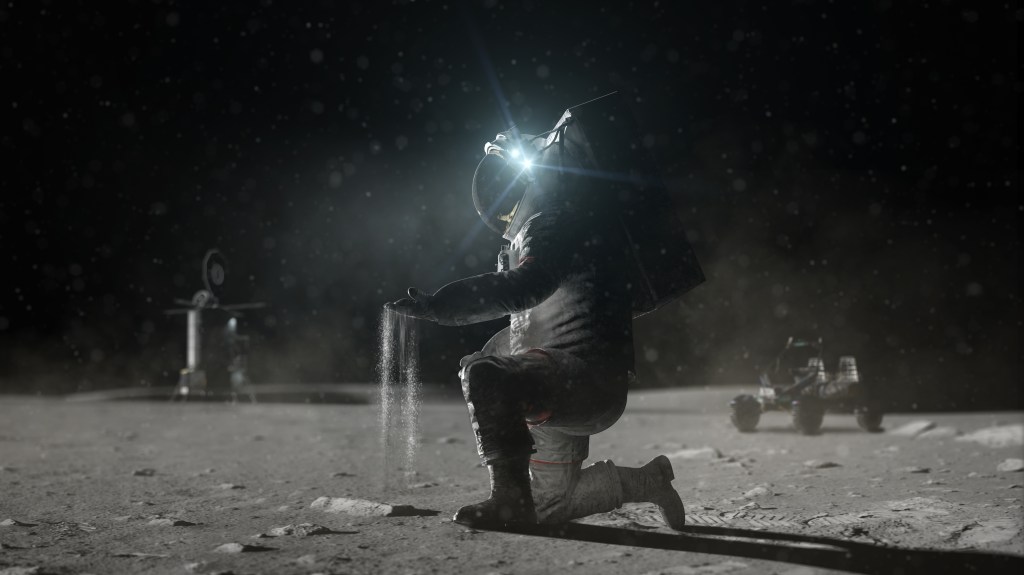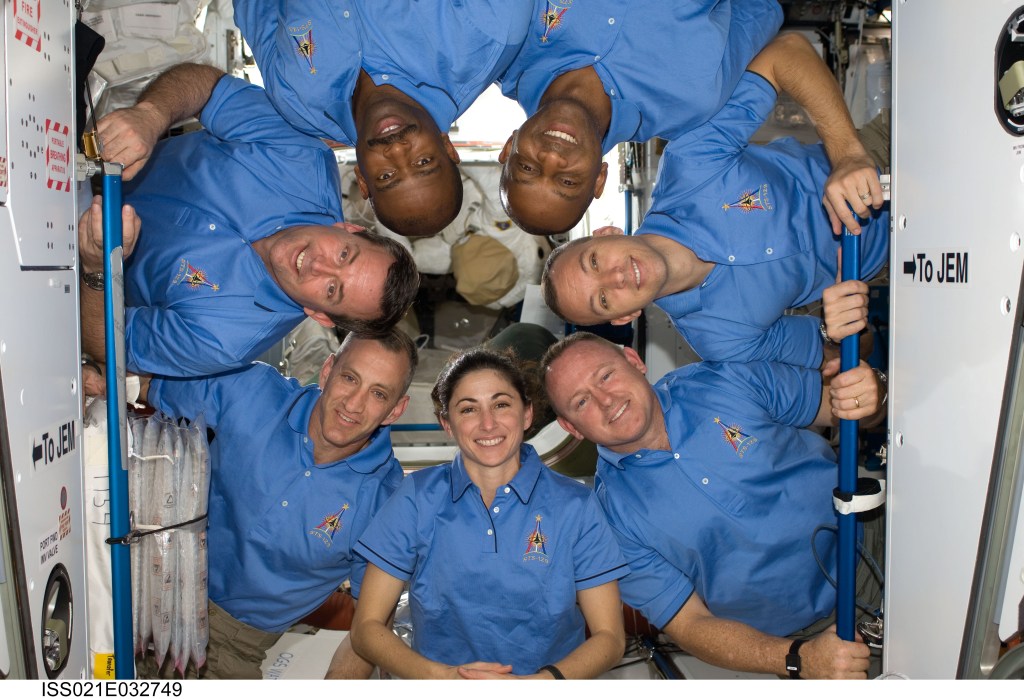
STS-108
The 12th flight to the International Space Station and final flight of 2001, the STS-108 mission launched aboard the Space Shuttle Endeavour on December 5, 2001. They were accompanied to the ISS by the Expedition Four crew, which remained on board the orbital outpost for several months. The Expedition Three crew members returned home with the STS-108 astronauts. In addition to the Expedition crew exchange, STS-108 crew deployed the student project STARSHINE, and delivered 2.7 metric tons (3 tons) of equipment and supplies to the ISS.
Orbiter
mission duration
Launch
Landing

Mission Facts
Mission: International Space Station Assembly Flight UF-1
Space Shuttle: Endeavour
Launch Pad: 39B
Launched: December 5, 2001, 5:19:28 p.m. EST
Landing Site: Kennedy Space Center, Florida
Landing: December 17, 2001, 12:55 p.m. EST
Runway: 15
Rollout Distance: 8,941 feet
Revolution: 186
Mission Duration: 11 days, 19 hours, 55 minutes
Miles Traveled: 4.8 million
Crew
Dominic L. Gorie, Commander
Mark E. Kelly, Pilot
Linda M. Godwin, Mission Specialist
Daniel M. Tani, Mission Specialist
Launch Highlights
The launch of space shuttle Endeavour on November 29 was rescheduled for Tuesday, December 4, to allow sufficient time for the Expedition Three crew on the space station to successfully complete a spacewalk to clear an obstruction on the latching mechanism on the Russian Progress supply vehicle.
The launch December 4 was postponed due to unsatisfactory weather conditions in the KSC area. Launch controllers counted down to the T-5 minute point and held until the remainder of the window expired. The scrub had to be called after Astronaut Office Chief Charles Precourt, flying the Shuttle Training Aircraft, detected precipitation in a cloud mass that moved into the Complex 39 area shortly before launch.
Endeavour lifted off December 5 on the final space shuttle mission of 2001 to deliver three tons of supplies and a fresh crew to the International Space Station, and return home a crew that spent four months in space.
In addition to a new station crew and supplies, Endeavour carried a host of scientific investigations, including experiments from space agencies, schools and universities across the United States, Europe and South America, as well as a small satellite that involved more than 25,000 students in 26 countries.
Mission Highlights
Shuttle Commander Dom Gorie brought Endeavour to a gentle linkup with the ISS at 3:03 p.m. EST as the two craft sailed over England. Within minutes, Pilot Mark Kelly and Mission Specialists Linda Godwin and Dan Tani began to conduct post-docking checks of the mechanical interface between Endeavour and the station’s Destiny Laboratory prior to the opening of the hatches on the two vehicles. At first, the shuttle’s docking ring and the docking mechanism on the ISS did not align properly, but after allowing the two craft to dampen their relative motion against one another, the vehicles were hard mated for a week of joint operations by the 10 crew members.
The hatches were opened between Endeavour and the ISS Destiny Laboratory at 5:42 p.m. EST Dec. 7, enabling the ten crew members to greet one another. The Expedition 3 crew officially ended their 117-day residency on board the International Space Station Dec. 8 as their custom Soyuz seatliners were transferred to Endeavour for the return trip home. The transfer of the Expedition 4 seatliners to the Soyuz return vehicle attached to the station marked the official exchange of crews.
Endeavour Pilot Mark Kelly and Mission Specialist Linda Godwin used the shuttle’s robotic arm to lift the Raffaello Multi-Purpose Logistics Module from the shuttle payload bay and attach it to a berth on the station’s Unity node. The crews began unloading supplies the same day.
The 10 astronauts and cosmonauts in orbit took a break from the transfer of supplies, experiments and equipment to and from the space shuttle Endeavour and the International Space Station to pay tribute to the heroes of the September 11 attacks on New York and the Pentagon. Joined by flight controllers in Mission Control, the crews observed the playing of the U.S. and Russian national anthems at 8:46 a.m. EST, the three-month anniversary of the first impact at the World Trade Center.
Also, aboard Endeavour were 6,000 small United States flags that would be distributed to heroes and families of the victims of the attacks after the shuttle returned to Earth; a U.S. flag that was found at the World Trade Center site after the attacks; a U.S. flag that had flown above the Pennsylvania state capitol; a U.S. Marine Corps Colors flag from the Pentagon; a New York Fire Department flag; and a poster that included photographs of firefighters lost in the attacks.
EVA: 4 hours, 12 minutes — Endeavour astronauts Linda Godwin and Dan Tani completed a four-hour, 12-minute spacewalk to install insulation on mechanisms that rotate the International Space Station’s main solar arrays. The two spacewalkers stopped at a stowage bin to retrieve a cover that had been removed from a station antenna during an earlier flight, and after its return to Earth, may be reused. Godwin and Tani also performed a “getahead;” task, positioning two switches on the station’s exterior to be installed on a future shuttle mission, STS-110. The spacewalk completed a record year with 18 spacewalks conducted: 12 originating from the shuttle and six from the station.
Mission managers extended Endeavour’s flight to a duration of 12 days to allow Endeavour’s crew to assist with additional maintenance tasks on the station, including work on a treadmill and replacing a failed compressor in one of the air conditioners in the Zvezda Service Module.
The astronauts and cosmonauts completed the transfer of more than 5,000 pounds of supplies and material from Endeavour’s mid-deck and the Raffaello Multi-Purpose Logistics Module to the station. The transferred items included more than 850 pounds of food, 1,000 pounds of clothing and other crew provisions, 300 pounds of experiments and associated equipment, 800 pounds of spacewalking gear, and 600 pounds of medical equipment. In turn, the crew packed up the Raffaello module with items bound for a return trip to Earth.
On December 12, the crew and Mission Control noted a transient problem with one of the shuttle’s three inertial measurement units (IMUs), the primary navigation units for the shuttle. Only two of the three IMUs were on line at the time, with the third unit off line to save electricity. The IMU that experienced a problem, designated IMU 2, was immediately taken off line and the third IMU brought on line. IMU 2 operated well after that, but it remained off line and was considered failed by flight controllers. The loss of one IMU had no impact on Endeavour’s mission, and the other two units operated in excellent condition.
A formal change of command ceremony took place December 13 as Expedition 3 ended its residence and Expedition 4 began theirs.
Flight controllers planned slight changes to Endeavour’s departure from the station December 15, allowing time for a small jet firing by the shuttle to boost the station’s future path away from a piece of space debris that could pass near the complex. Mission Control was notified that a spent Russian rocket upper stage launched in the 1970s could pass within three miles of the station if Endeavour did not perform the engine firing. With the shuttle reboost, the station was predicted to pass more than 40 miles away from the debris.
Because the scheduled reboost used additional propellant, Endeavour did not perform a full-circle flyaround of the station after undocking. Instead, the shuttle undocked from the station, performing a quarter circle flyaround of the complex to a point about 400 feet directly above the station where it fired its engines in a final separation burn at 12:20 a.m. EST, beginning its departure from the orbiting outpost.
Endeavour’s middeck carried home the results of several experiments completed during Expedition 3’s stay on the station. These included the Advanced Protein Crystallization Facility, the Dynamically Controlled Protein Crystal Growth experiment and cells from the Cellular Biotechnology Operations Support System (CBOSS).
The CBOSS equipment aboard the space station will remain active during Expedition 4, growing ovarian and colon cancer cells, as well as kidney cells in microgravity.
Experiments in Endeavour’s payload bay were returned for investigators around the world. The Multiple Application Customized Hitchhiker-1 (MACH-1) carried a wide array of experiments, including the Prototype Synchrotron Radiation Detector, the Collisions Into Dust Experiment-2, the Capillary Pump Loop, and the Space Experiment Module (SEM). The SEM carried experiments from Argentina, Portugal, Morocco and Australia, as well as experiments from U.S. schoolchildren. Several other canisters in Endeavour’s payload bay also carried student experiments.
On its return to Earth, Endeavour’s crew deployed a small satellite called STARSHINE 2 from a canister located in the payload bay. More than 30,000 students from 660 schools in 26 countries will be tracking STARSHINE 2 as it orbits the Earth for eight months. The students, who helped polish STARSHINE’s 845 mirrors, will use the information they collect to calculate the density of the Earth’s upper atmosphere.
STS-108
Resources
Shuttle News
Retired Space Shuttle Locations
Shuttle Atlantis – Kennedy Space Center Visitor Complex Shuttle Discovery – Steven F. Udvar-Hazy Center Shuttle Endeavour – California Science…
Read the Story














































